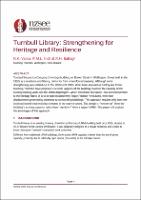| dc.contributor.author | Ballagh, Rowan | |
| dc.contributor.author | Inch, Rubie | |
| dc.contributor.author | Vance, Nicki | |
| dc.date.accessioned | 2024-07-01T02:01:08Z | |
| dc.date.available | 2024-07-01T02:01:08Z | |
| dc.date.issued | 2024-04-09 | |
| dc.identifier.uri | https://repo.nzsee.org.nz/xmlui/handle/nzsee/2679 | |
| dc.description.abstract | Turnbull House is a Category 1 Heritage building on Bowen Street in Wellington. It was built in the 1910s as a residence and library, primarily from unreinforced masonry. Although some strengthening was carried out in the 1950s and 1990s, it has been assessed as Earthquake Prone. Dunning Thornton have proposed a seismic upgrade based on the capacity of the existing rocking walls and the 1990s diaphragms, which minimises disruption and cost. The building is to be base isolated with Triple Friction Pendulums, with their displacement based on clearance to surrounding buildings. This requires only two new localised lateral load resisting elements in the superstructure. The design is “bottom-up” from the building’s existing capacity rather than “top-down” from a target %NBS. This paper will explain the advantages of this approach, including the interaction process with the client. | |
| dc.language.iso | en | |
| dc.publisher | New Zealand Society for Earthquake Engineering | |
| dc.relation.ispartofseries | 2024;67 | |
| dc.subject | Seismic performance, risk mitigation and resilience of new and existing structures | |
| dc.title | Turnbull Library: Strengthening for Heritage and Resilience | |
| dc.type | Article | |

